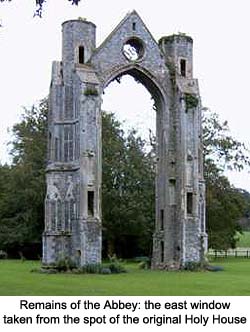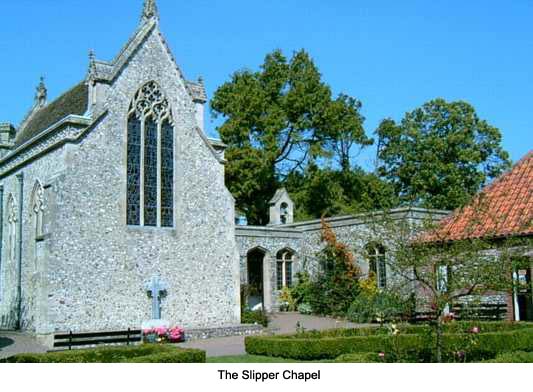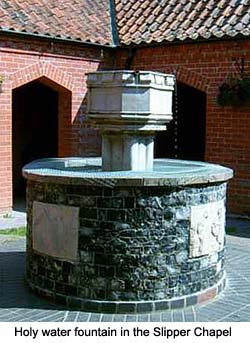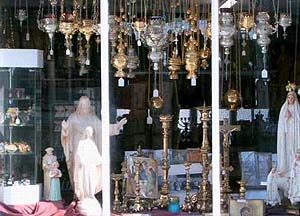Walsingham: England's Holiest Shrine
by John P. Seely
Little Walsingham lies hidden deep in the north corner of
Norfolk, approachable only by narrow, twisty lanes flanked by
high, thick hedgerows unchanged from the days when traffic went
on foot or by horseback. Little Walsingham too, has changed
little over the centuries. It still has its streets of medieval
timber-framed, jetted buildings, its ruined abbey, its Friday
Market Place ringed with Georgian public houses and hostelries,
its Common Place and its shops selling religious mementos for
pilgrims.
 Walsingham -- actually Little Walsingham as there are two
villages sharing the same name -- has a long and prestigious
history. Once known as the Nazareth of England, it ranked
alongside Rome and Jerusalem in importance as a place of
pilgrimage. It was visited by all of England's kings and queens,
starting with Henry III in 1226, up to and including Henry the
VIII, who visited twice, in 1486 as a prince and in1511 as king.
Henry the VIII was the last reigning monarch to visit as 20 years
later, the abbey fell to the reformation, and today lies in
ruins.
Walsingham -- actually Little Walsingham as there are two
villages sharing the same name -- has a long and prestigious
history. Once known as the Nazareth of England, it ranked
alongside Rome and Jerusalem in importance as a place of
pilgrimage. It was visited by all of England's kings and queens,
starting with Henry III in 1226, up to and including Henry the
VIII, who visited twice, in 1486 as a prince and in1511 as king.
Henry the VIII was the last reigning monarch to visit as 20 years
later, the abbey fell to the reformation, and today lies in
ruins.
The origins of Walsingham as a holy site are lost to us. The
earliest account is found in The Foundation of the Chapel of
Walsingham by Richard Pynson, printed in 1465, possibly
published for sale to pilgrims. Also known as the Pynson
Ballad, it gives an account in verse of the events leading up
to the building of a replica of the house in Nazareth where the
Annunciation of the Virgin Mary took place.
Of this chapcll se here the fundacyon,
Bylded the yere of Crystes incarnacyon,
A thousande complete syxty and one,
The tyme of sent Edward kyng of this region.
The ballad goes to on to relate how, in 1061, the lady of the
manor, Richeldis de Faverches, had a series of visions of the
Virgin Mary, in which she was taken to the Virgin's house in
Nazareth, told to memorize its dimensions and build an exact
replica in Walsingham. This she proceeded to do after having
chosen a site "Where neyther moyster ne dewe myght be
fowne."
But there is trouble with the building and Richeldis prays
for further guidance. During the night her prayers are answered.
She had obviously chosen the wrong spot, for in the morning the
house is found completed, but moved some 200 yards from its
original site. This fact is confirmed by the artisans when they
turn up for work that morning. They go even further, and claim
that the quality of workmanship is beyond their capabilities.
Word of this miracle got around; supplicants began making
pilgrimages and Walsinghams reputation and importance grew.
Many seke ben here cured by Our Ladyes myghte
Dede agayne reuyued, of this is no dought,
Lame made hole and blynde restored to syghte,
Maryners vexed with-tempest safe to porte brought
Defe, wounded and lunatyke that hyder haue sought
And also lepers here recouered haue be
By Oure Ladyes grace of their infyrmyte.
 In 1150, the Augustinian Canons built the Priory of
the Annunciation of the Blessed Virgin Mary, St Mary's Priory for
short, next to the Holy House. The increasing number of pilgrims
during the 14th century led to the building of a large church,
enclosing the original wooden house in a stone chapel known as
the Novum Opus. The site of the Holy House was excavated in 1961
and can be seen today in the ruins of the priory. All that
remains of the priory is the wall containing the magnificent east
window, ruins of the west porch, refectory, crypt and pool with
twin wells. Most of the original high walls surrounding the
priory grounds are still intact. In 1150, the Augustinian Canons built the Priory of
the Annunciation of the Blessed Virgin Mary, St Mary's Priory for
short, next to the Holy House. The increasing number of pilgrims
during the 14th century led to the building of a large church,
enclosing the original wooden house in a stone chapel known as
the Novum Opus. The site of the Holy House was excavated in 1961
and can be seen today in the ruins of the priory. All that
remains of the priory is the wall containing the magnificent east
window, ruins of the west porch, refectory, crypt and pool with
twin wells. Most of the original high walls surrounding the
priory grounds are still intact.
The Franciscan Friars, under the patronage of Elizabeth de Burgh,
Countess of Clare, established a small Friary on the edges of the
village in 1347. The friary also fell victim to the reformation,
and the extensive ruins are visible from the road today.
The village of Walsingham developed in response to the increasing
importance of the site. Hostelries and inns were built to serve
the needs of ever more pilgrims. By 1252, the village had been
laid out to a rough grid, pretty much as it is today. It was
granted a charter to hold a weekly market on Fridays and a fair
to be held once a year. Walsingham became England's holiest
shrine and was visited by pilgrims from all over the British
Isles and Europe.
The tiny Slipper Chapel, today a Roman Catholic shrine and center
of pilgrimage, was built one mile south of the village as the
last pilgrim chapel before Walsingham, and was dedicated to St
Catherine. It was traditional to complete the pilgrimage barefoot
from here, the "Holy Mile", hence the name of the
chapel. Today the tradition is maintained but in the opposite
direction. Pilgrims arrive in Walsingham and from the Friday
Market Place walk barefoot to the slipper chapel. The road is
very narrow, being barely wide enough for a car, and slightly
below the level of the fields. About half way to the slipper
Chapel a farm track off the road leads to a bridge over a fast
stream, the River Stiffkey, and makes a delightful picnic
spot.
 Another important stop on the route to Walsingham was the
Shrine of Our Lady of Walsingham in King's Lynn, 23 miles
to the north, which was refounded by Pope Leo XIII in 1897, the
year pilgrimages to Walsingham started again.
Another important stop on the route to Walsingham was the
Shrine of Our Lady of Walsingham in King's Lynn, 23 miles
to the north, which was refounded by Pope Leo XIII in 1897, the
year pilgrimages to Walsingham started again.
Walsingham didn't escape the reformation that swept England in
the early 16th century. Under Cromwell's direction, control of
the church and religious practice in England was wrested from
Rome and passed to the King, Henry VIII, who was declared head of
the Church of England. In so doing he gained almost absolute
control over all aspects of English life. Sweeping reforms were
made in many aspects of religious practice, including the
dissolution of the monasteries which had anyway lost their
importance, and become less places of religious life than
self-serving corporations. In 1537, after several uncertain and
fateful years in which shrines and churches throughout England
were desecrated, statues destroyed, and lesser religious houses
closed, the Priory and Friary at Walsingham were also dissolved,
their lands passing to the crown. This was despite Walsingham
being one of the first religious houses to sign the Oath of
Supremacy in 1534, recognizing Henry VIII's marriage to Anne
Boleyn, and accepting Henry as head of the Church in England. The
Prior of Walsingham received a pension of £100 a year, but
the sub-prior, who refused to sign the oath, was executed.
 Once the instability resulting from the reformation
and counter-reformation passed, pilgrims slowly returned to
Walsingham, but in far fewer numbers, and the priory was never
reopened. Amon those who visited were Queen Elizabeth I in 1578,
and John Wesley who preached there in 1781. Once the instability resulting from the reformation
and counter-reformation passed, pilgrims slowly returned to
Walsingham, but in far fewer numbers, and the priory was never
reopened. Amon those who visited were Queen Elizabeth I in 1578,
and John Wesley who preached there in 1781.
Walsingham itself continued as a market town and legal center.
Quarter sessions were held here until 1861 and petty sessions
until 1971. From 1773 the court was held in the shirehall,
formerly a hostelry, actually built into the priory walls and it
was at this time that many of the buildings received their fine
Georgian façades. Today the shirehall is the visitor
center and museum. The court is still there so you can wander
around and try out what it felt like to be the magistrate (or the
defendant). The rest of the small museum is a display on
Walsingham as a place of pilgrimage and as an agricultural
community. It's open from the start of April until the end of
October and on weekends the rest of the year. The museum is also
the entrance to the priory ruins and grounds, now owned by the
Lee-Warner family. When the shirehall is closed you can get to
the priory through the estate office during normal business
hours.
Walsingham Today
 Today the
streets are full of visitors, business is booming in the
hostelries and B&Bs whilst shops again sell statues of Our
Lady of Walsingham and bottles for filling with holy water. Once
more Walsingham is England's national shrine and thousands of
pilgrims visit every year. Today the
streets are full of visitors, business is booming in the
hostelries and B&Bs whilst shops again sell statues of Our
Lady of Walsingham and bottles for filling with holy water. Once
more Walsingham is England's national shrine and thousands of
pilgrims visit every year.
The slipper chapel was rescued from being a cattle byre and barn
and presented to the Catholic Church in 1896, and on the 20th of
August 1897 the first pilgrimage to Walsingham since the
reformation took place. The slipper chapel is one of England's
smallest churches, and certainly one of the most atmospheric.
Around it has been built a pilgrimage center featuring a large
central fountain. Visitors splash water on themselves and fill
bottles to take back home. The annual pilgrimage in September is
made by thousands of faithful from across the country.
Back in town, across from the priory ruins, the Anglican Shrine
of Our lady of Walsingham has been built. This is a large complex
set in attractive and peaceful gardens complete with artificial
caves supposed to be a copy of the Holy Sepulcher in Jerusalem.
The large church here contains a replica of the Holy House in
Nazareth and a large statue of Our Lady of Walsingham. This has
been declared the National Shrine of England and also receives
thousands of visitors every year. The natural spring in the
basement of the church is open to the public on Fridays. At other
times the holy water is provided in buckets for drinking here or
taking away.
Looking in the shop windows the visitor is surprised to find
statues of the Virgin Mary, St Sebastian and St Francis, whilst
inside the walls are covered in displays of prayers and
petitions. And I know of know of no other shop in England whose
front window carries a display of chalices, crucifixes and tooled
leather cases to take the holy sacraments to those in need.
 The priory is a peaceful garden
dominated by the ruined east window of the church. The grounds
are a delight to wander through. Entering from the museum the
east window is directly in front and the site of the Holy House
inside the 15th century Novum Opus is to your left, marked by a
wooden cross. Beyond the ruins are woods and meadows with
footpaths throughout. The river Stiffkey passes though the woods
and a small humpbacked bridge called the Packhorse Bridge crosses
the river. By following the path you will come out of the estate
onto a small lane, Sunk Road, which leads back into the village
passing the Parish church of St Mary's and All Saints. This is a
large, airy 14th century building with one of the finest fonts in
Norfolk, which largely escaped damage during the Reformation. And
how many churches have a four-poster bed in the chancel? The priory is a peaceful garden
dominated by the ruined east window of the church. The grounds
are a delight to wander through. Entering from the museum the
east window is directly in front and the site of the Holy House
inside the 15th century Novum Opus is to your left, marked by a
wooden cross. Beyond the ruins are woods and meadows with
footpaths throughout. The river Stiffkey passes though the woods
and a small humpbacked bridge called the Packhorse Bridge crosses
the river. By following the path you will come out of the estate
onto a small lane, Sunk Road, which leads back into the village
passing the Parish church of St Mary's and All Saints. This is a
large, airy 14th century building with one of the finest fonts in
Norfolk, which largely escaped damage during the Reformation. And
how many churches have a four-poster bed in the chancel?
At the beginning I said that Walsingham was approachable only by
narrow twisty lanes. This isn't quite true, as there is another,
rather special, way. Riding the world's longest 101/4 inch (ten
and a quarter)narrow gauge steam railway. Trains run a scheduled
service to and from Wells-next-the-Sea, a 20-minute bone-jarring
ride, but a unique way to make a pilgrimage.
Getting There:
Walsingham is in north Norfolk about 27 miles from Norwich along
the A1067, turn right at Fakenham and follow the signs. To take
the North Norfolk Light Railway, head for Well-Next-The-Sea (yes
it's on the coast) between Cromer and Hunstanton.
More Information:
We regret that we no longer have the resources to maintain up-to-date links and/or hours and pricing details for the various sites and attractions listed on this website. For more information about the location(s) listed above, please use your favorite search engine or visit Wikipedia.
John Seely is a freelance writer living in Thailand, who returns regularly to England. He writes regularly for local magazines and has also been published in International Living, Transitions Abroad
and Gonomad. Samples of his work can be found at http://www.johnpseely.com/Travelarticles.htm.
Article and photos © 2006 John Seely
|
